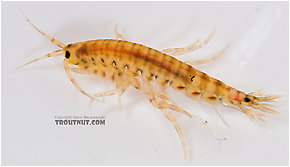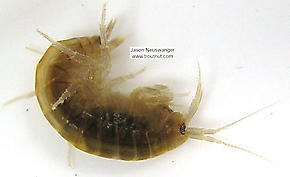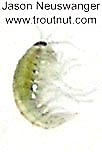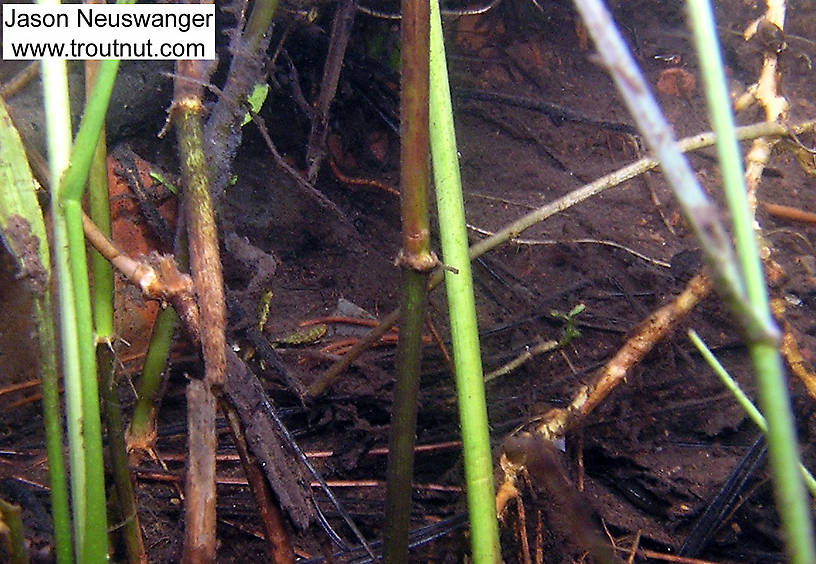Blog & Latest Updates
Fly Fishing Articles
Insects by Common Name


Arthropod Order Amphipoda (Scuds)
Taxonomic Navigation -?-
Common Name
| Match | Common Name |
| Scuds |
They are crustaceans so they don't go through the same life-cycle complications as aquatic insects. They start out as small scuds, grow to be big scuds, and die. The most significant family to anglers is Gammaridae with the species of the Gammarus genus heading up the list. The smaller Hyalella species of the Talitridae can also be important.
Though they all share the same silhouette, they can come in a surprising variety of sizes and colors. They run from size 8 to as small as you wish to imitate. The most common colors are olive or tan, though they can be found with yellow or gray base colors as well. Shading is often illusive to describe with highlights of pink, orange, green and even blue at times. It pays for anglers to notice both size and color differences in the waters they fish.
Where & When
Regions: East, Midwest, West
Preferred Waters: Best in alkaline (Alkaline: Having a pH higher than 7 (opposite of acidic). Moderately alkaline water is ideal for trout because it's better for the growth of phytoplankton, the usual base of the aquatic food chain, and that's good for the growth of everything higher up the chain, including trout.) water
Scuds are present year-round. They do very well in both lakes and streams. This is especially so in the West with its greater abundance of the alkaline (Alkaline: Having a pH higher than 7 (opposite of acidic). Moderately alkaline water is ideal for trout because it's better for the growth of phytoplankton, the usual base of the aquatic food chain, and that's good for the growth of everything higher up the chain, including trout.) stillwaters preferred by these critters. They're generally associated with slow water and do seem to be the most common there, especially in spring creeks and lakes or ponds with extensive weedy littoral zones (shallows). But some swift-flowing streams still hold good scud populations, and they can even be found in the riffles. Preferred Waters: Best in alkaline (Alkaline: Having a pH higher than 7 (opposite of acidic). Moderately alkaline water is ideal for trout because it's better for the growth of phytoplankton, the usual base of the aquatic food chain, and that's good for the growth of everything higher up the chain, including trout.) water
Scuds are very sensitive to light and prefer to remain deeply hidden during the day. Overcast days and periods of low light are the best times for anglers to use their imitations.
Amphipoda Fly Fishing Tips
Highly imitative flies have proven very successful and many anglers swear by them. Gravid female designs with their flashy segments of bright orange may give them that extra "edge" of attraction at times. Most anglers prefer special scud hooks with exaggerated short and rounded shanks, especially for dead drifting. Traditional hooks still have their place for use with active retrieves.
Some respected angling authorities however suggest that fuzzy Hares Ears, Birds Nests, and Zug Bugs are equally effective. They consider specialized scud patterns an unnecessary extravagance taking up precious space in their fly boxes. This is a valid consideration, especially for those anglers that don't regularly fish water where these crustaceans are important. Regardless of fly selection, fishing them in and around weed beds with known populations is often a good choice in low light conditions.
Pictures of 4 Scud Specimens:
Amphipoda (Scuds) Scud Adult View 7 Pictures
View 7 Pictures
 View 7 Pictures
View 7 PicturesCollected March 29, 2006 from Salmon Creek in New York
Added to Troutnut.com by Troutnut on April 7, 2006
Added to Troutnut.com by Troutnut on April 7, 2006
Amphipoda (Scuds) Scud Adult View 4 Pictures
View 4 Pictures
 View 4 Pictures
View 4 PicturesCollected January 31, 2004 from unknown in Wisconsin
Added to Troutnut.com by Troutnut on January 25, 2006
Added to Troutnut.com by Troutnut on January 25, 2006
Amphipoda (Scuds) Scud Adult View 3 Pictures
View 3 Pictures
 View 3 Pictures
View 3 PicturesCollected January 31, 2004 from unknown in Wisconsin
Added to Troutnut.com by Troutnut on January 25, 2006
Added to Troutnut.com by Troutnut on January 25, 2006
1 Underwater Picture of Scuds:

A water boatman and a scud are visible in this picture. Can you find them?
In this picture: True Bug Family Corixidae (Water Boatmen) and Arthropod Order Amphipoda (Scuds).
In this picture: True Bug Family Corixidae (Water Boatmen) and Arthropod Order Amphipoda (Scuds).
StateWisconsin
LocationBois Brule River
Date TakenApr 13, 2004
Date AddedJan 25, 2006
AuthorTroutnut
CameraOlympus C740UZ
Recent Discussions of Amphipoda
Pakistani amphipods
Posted by Halabano on Apr 3, 2009
Hi! i m working on Pakistani amphipods. i want to be intouch with scientists & students working on amphipods taxonomy & ecology
ReplyThere is 1 more topic.
Your Thoughts On Amphipoda:
Top 10 Fly Hatches
Top Gift Shop Designs
Eat mayflies.
Top Insect Specimens
Miscellaneous Sites
Troutnut.com is copyright © 2004-2024 Jason
Neuswanger (email Jason). See my FAQ for information about use of my images.
 privacy policy
privacy policy
